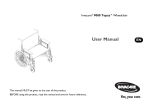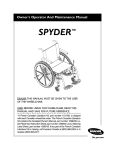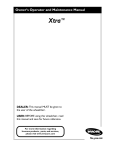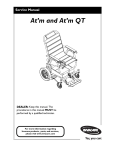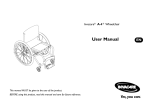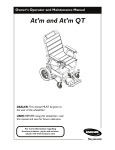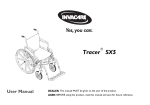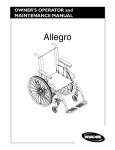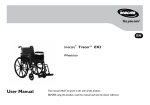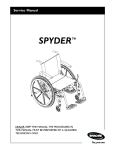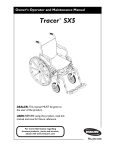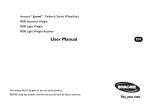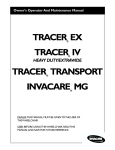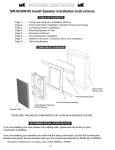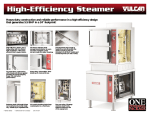Download MVP™ MVP jr.™
Transcript
Owner's Operator And Maintenance Manual MVP MVP jr. DEALER: THIS MANUAL MUST BE GIVEN TO THE USER OF THE WHEELCHAIR. USER: BEFORE USING THIS WHEELCHAIR, READ THIS MANUAL AND SAVE FOR FUTURE REFERENCE. WARNING WARNING WARNING DO NOT OPERATE THIS EQUIPMENT WITHOUT FIRST READING AND UNDERSTANDING THIS MANUAL. IF YOU ARE UNABLE TO UNDERSTAND THE WARNINGS, CAUTIONS AND INSTRUCTIONS, CONTACT A QUALIFIED TECHNICIAN BEFORE ATTEMPTING TO USE THIS EQUIPMENT - OTHERWISE INJURY OR DAMAGE MAY RESULT. THE INITIAL SET UP OF THIS WHEELCHAIR MUST BE PERFORMED BY A QUALIFIED TECHNICIAN. PROCEDURES OTHER THAN THOSE DESCRIBED IN THIS MANUAL MUST BE PERFORMED BY A QUALIFIED TECHNICIAN. THE FOLLOWING PROCEDURES ARE FOUND IN THE SERVICE MANUAL. REPLACING THE LOCKING MECHANISM IN THE BACK CANE ADJUSTING THE BACK ANGLE - EXTENDED REAR FRAME REPLACING OPTIONAL BACK UPHOLSTERY ADJUSTABLE BACK UPHOLSTERY CHANGING/REPOSITIONING SEAT RAILS ADJUSTING THE SEAT WIDTH ADJUSTING THE SEAT DEPTH CONVERTING FROM SPACE SAVER TO CONVENTIONAL ARMS OR CONVENTIONAL TO SPACE SAVER ARMS CONVERTING FROM DUAL POINT ARMS TO HALF ARMS REPOSITIONING THE DUAL POINT ARMS INSTALLING T-ARM SOCKETS REPLACING THE T-ARM LOCKING LEVER REPLACING/REPOSITIONING THE LOCKING MECHANISM IN THE CANTILEVER ARM REPLACING/REPOSITIONING/INSTALLING FRONT CASTER ASSEMBLIES INSTALLING/REPLACING FRONT CASTER FORKS ADJUSTING CASTER HEADTUBES REPOSITIONING CASTER HEADTUBES ON WHEELCHAIR FRAME INSTALLING QUICK-RELEASE CASTERS HANDRIMS ADJUSTING REAR WHEEL CAMBER ADJUSTING WHEELBASE LENGTH ADJUSTING WHEELBASE LENGTH TOE-IN/TOE-OUT ALIGNMENT CORRECTING THE TOE-IN/TOE-OUT CONDITION SEAT-TO-FLOOR HEIGHT DETERMINATION CHANGING SEAT-TO-FLOOR HEIGHT INSTALLING ANTI-TIPPER MOUNTING BRACKETS SAVE THESE INSTRUCTIONS MVP & MVP jr. 2 Part No. 1106638 TABLE OF CONTENTS TABLE OF CONTENTS SPECIAL NOTES ............................................................................... 5 SPECIFICATIONS ............................................................................. 7 SECTION 1 - GENERAL GUIDELINES ................................................. 9 STABILITY ....................................................................................................................................................... 9 OPERATING INFORMATION .............................................................................................................. 10 WHEELS AND TIRE PRESSURE ........................................................................................................... 11 WEIGHT TRAINING ............................................................................................................................... 11 WEIGHT LIMITATION ........................................................................................................................... 11 SAFETY/HANDLING OF WHEELCHAIRS ....................................................................................... 12 SECTION 2 - SAFETY INSPECTION ................................................. 18 SAFETY INSPECTION CHECKLIST ................................................................................................... 18 TROUBLESHOOTING ............................................................................................................................. 19 MAINTENANCE ........................................................................................................................................ 19 SECTION 3 - FRONT RIGGINGS ...................................................... 21 INSTALLING/REMOVING/ADJUSTING THE FOOTREST(S) .................................................... 21 INSTALLING ELEVATING LEGRESTS ................................................................................................ 23 RAISING/LOWERING ELEVATING LEGRESTS ............................................................................. 24 ADJUSTING CALFPADS ......................................................................................................................... 24 USING THE FLIP-UP FOOTREST ........................................................................................................ 25 ADJUSTING THE FLIP-UP FOOTREST ............................................................................................. 26 INSTALLING ADJUSTABLE ANGLE FLIP-UP FOOTPLATE HINGE ....................................... 27 ADJUSTING ADJUSTABLE ANGLE FLIP-UP FOOTPLATES ...................................................... 28 HEEL LOOP REPLACEMENT ................................................................................................................ 29 INSTALLING IMPACT GUARDS/CALF STRAP .............................................................................. 30 REMOVING/INSTALLING/ADJUSTING THE ADJUSTABLE ANGLE ONE PIECE FOOTBOARD ...................................................................................................................................... 30 SECTION 4- BACK ......................................................................... 32 FOLDING/UNFOLDING THE BACK ................................................................................................. 32 ADJUSTING THE BACK HEIGHT ....................................................................................................... 33 ADJUSTING THE BACK ANGLE - SQUARE REAR FRAME ...................................................... 34 INSTALLING/REMOVING THE CHEST POSITIONING STRAP .............................................. 35 INSTALLING/ADJUSTING THE STROLLER HANDLES .............................................................. 36 INSTALLING AND REMOVING A SEATING SYSTEM ................................................................ 37 FOLDING/UNFOLDING THE WHEELCHAIR ................................................................................ 38 Part No. 1106638 3 MVP & MVP jr. TABLE OF CONTENTS LABEL LOCATIONS .......................................................................... 6 TABLE OF CONTENTS TABLE OF CONTENTS SECTION 5 - SEAT ......................................................................... 38 REPLACING SEAT UPHOLSTERY ...................................................................................................... 39 INSTALLING/REMOVING SEAT POSITIONING STRAP ............................................................ 40 INSTALLING FABRIC CLOTHING GUARDS.................................................................................. 41 INSTALLING RIGID CLOTHING GUARDS ..................................................................................... 41 INSTALLING THE HALF ARM .............................................................................................................. 42 SECTION 6 - ARMS ........................................................................ 42 ADJUSTING HALF ARM HEIGHT ....................................................................................................... 44 USING/ADJUSTING DUAL POINT ARMS ....................................................................................... 45 REPLACING DUAL POINT ARM PAD .............................................................................................. 45 REPLACING DUAL POINT ARM CLOTHING GUARDS ........................................................... 45 INSTALLING/REMOVING T-ARMS .................................................................................................... 46 ADJUSTING THE T-ARMS ..................................................................................................................... 47 ADJUSTING T-ARM TRANSFER ASSISTS AND/OR SIDE GUARDS ...................................... 49 CANTILEVER ARM PAD DEPTH ADJUSTMENT/REPLACEMENT ......................................... 51 SECTION 7 - WHEELS ..................................................................... 52 REPAIRING/REPLACING PNEUMATIC TIRE/TUBE .................................................................... 52 REMOVING/INSTALLING REAR WHEELS ...................................................................................... 52 ADJUSTING QUICK-RELEASE AXLES .............................................................................................. 53 ADJUSTING QUAD-RELEASE HANDLES ........................................................................................ 54 INSTALLING QUAD-RELEASE AXLES .............................................................................................. 54 ADJUSTING FORKS ................................................................................................................................. 55 REPLACING/ADJUSTING THE WHEEL LOCKS ........................................................................... 56 INSTALLING/ADJUSTING THE ANTI-TIPPERS............................................................................. 57 LIMITED WARRANTY .................................................................... 60 MVP & MVP jr. 4 Part No. 1106638 SPECIAL NOTES SPECIAL NOTES WARNING/CAUTION notices as used in this manual apply to hazards or unsafe practices which could result in personal injury or property damage. WHEELCHAIR USER As a manufacturer of wheelchairs, Invacare endeavors to supply a wide variety of wheelchairs to meet many needs of the end user. However, final selection of the type of wheelchair to be used by an individual rests solely with the user and his/her health care professional capable of making such a selection. WHEELCHAIR TIE-DOWN RESTRAINTS AND SEAT POSITIONING STRAPS Invacare recommends that wheelchair users NOT be transported in vehicles of any kind while in wheelchairs. As of this date, the Department of Transportation has not approved any tie-down systems for transportation of a user while in a wheelchair, in a moving vehicle of any type. It is Invacares position that users of wheelchairs should be transferred into appropriate seating in vehicles for transportation and use be made of the restraints made available by the auto industry. Invacare cannot and does not recommend any wheelchair transportation systems. AS REGARDS TO RESTRAINTS - SEAT POSITIONING STRAPS - IT IS THE OBLIGATION OF THE DME DEALER, THERAPISTS AND OTHER HEALTH CARE PROFESSIONALS TO DETERMINE IF A SEAT POSITIONING STRAP IS REQUIRED TO ENSURE THE SAFE OPERATION OF THIS EQUIPMENT BY THE USER. SERIOUS INJURY CAN OCCUR IN THE EVENT OF A FALL FROM A WHEELCHAIR. Part No. 1106638 5 MVP & MVP jr. SPECIAL NOTES NOTICE THE INFORMATION CONTAINED IN THIS DOCUMENT IS SUBJECT TO CHANGE WITHOUT NOTICE. LABEL LOCATIONS LABEL LOCATIONS LABEL LOCATIONS WARNING Detent balls should extend beyond the diameter of the axle bushing for a positive lock. Keep detent balls clean. WARNING DO NOT OPERATE WITHOUT THE ANTI-TIP TUBES INSTALLED. P/N 60106X144 REV. 5/98 MVP jr. ONLY MVP ONLY MVP Heavy Duty ONLY MVP & MVP jr. 6 Part No. 1106638 SPECIFICATIONS SPECIFICATIONS MVP & MVP jr. OPEN - Seat width plus approximately 9-inches CLOSED - approximately 14-inches SPECIFICATIONS Overall Width (with 0° Camber): Overall Depth (w/o Front Riggings): Seat Depth plus 14-inches Seat Width: 12 to 22-inches Seat Depth: 12 to 22-inches Rear Frame Types: Curved, Square, Extended Front Frame Types: Swingaway, 60° Fixed, 80° Fixed Crossbrace Types: Conventional or Less Seat Rail Seat-to-Floor: If chair is equipped with Less Seat Rail Crossbrace, subtract 1-1/2-inches from measurements listed below. REAR Wheel Sizes 16-inch 18-inch 20-inch 22-inch 24-inch, Carbon/Turbo/Spinergy 25-inch, Spinergy 26-inch, Primo/Continental 26-inch, Spinergy 700C Curved Rear Frame 11-1/2 to 14-inches 12-1/2 to 15-inches 13-3/4 to 16-1/4-inches 14-3/4 to 17-1/2-inches 15-3/4 to 18-1/2-inches 16-1/4 to 18-3/4-inches 16-1/4 to 18-3/4-inches 16-3/4 to 19-1/4-inches 17 to 19-3/4-inches Other Rear Frames 12-1/4 to 15-1/4-inches 13-1/4 to 16-1/4-inches 14-1/2 to 17-3/4-inches 15-1/2 to 18-3/4-inches 16-1/2 to 19-1/2-inches 17 to 20-inches 17 to 20-inches 17-1/2 to 20-1/2-inches 17-3/4 to 20-3/4-inches FRONT Caster Sizes 3-inch 5-inch 6-inch 8-inch Swingaway Front Frame 15-1/4 to 18-3/4-inches 16 to 19-3/4 17 to 20-1/4 18-3/4 to 21-1/4 Fixed Front Frame 14-3/4 to 18-inches 15-1/2 to 19 17-1/2 to 19-1/2 18-1/4 to 20-1/2 Back Height: Back Style Push Handles - 10° bend Sportster - No Push Handles Straight - Push Handles Straight - Push Handles Fixed Height Adjustable Angle (Square Frame) Adjustable Angle (Square Frame) Size/Range 14 to 18-inches 10 to 14-inches 12 to 16-inches 14 to 18-inches 12 to 20-inches 12 to 16-inches 17 to 20-inches Back Angle Range Conventional Crossbraces: Less Seat Rail Crossbraces: Extended Rear Frame 0° to 20° -20° to 20° Square Rear Frame 0° to 15° -15° to 15° Arm Styles: Dual Point, T-Arm, Cantilever, Half Arm Part No. 1106638 7 MVP & MVP jr. SPECIFICATIONS SPECIFICATIONS (CONTINUED) SPECIFICATIONS MVP & MVP jr. o o o Footrest: SWINGAWAY FRONT FRAME - 60 , 70 , 90 Swingaway, Tapered, Non-Tapered, Elevating Legrest, Adjustable Angle Flip-up Footplates, Composite Footplates FIXED FRONT FRAME o 60 with Adjustable Angle Rigid Footrest o 80 with Individual Adjustable Angle Flip-up Footrest o 80 with Tubular Anodized Rigid Footrest, Tubular Plastic Coated Rigid Footrest or Adjustable Angle Rigid Footrest Rear Axle: Quick-Release, Quad-Release, Permanent Axle Mounting Plates: Standard, Extended Rear Wheels: 16, 18, 20, 22, 24-inch Composite Wheels 22, 24, 26-inch Spoke Wheels 24, 26-inch Hi-Performance Spoke Wheels 27-inch 700C Spoke Wheel 559 High Performance/Turbo Tire 24, 25, 26-inch Spinergy OPTIONAL - 24, 26-inch Continental Tires, 22, 26-inch Pneumatic Tires, Flat Free Inserts Handrims: Aluminum Anodized, Plastic Coated, Black Plastic Coated, Vertical/Oblique Projection Plastic Coated, Spoke Guards Wheel Locks: Thumb Saver (Standard), High Mount Push to Lock, Wheel Lock Extensions, Hill Holder, Undermount Wheel Lock (Fixed Front End Only), Pull to Lock Caster Size: 3, 5, 6 and 8-inch (Urethane or Pneumatic), Precision Sealed Bearings Flat Free Inserts Seat Cushion: 2 or 3-inch (Optional) Back Upholstery: Black Nylon (Standard), Adjustable Back Upholstery (Optional) Shipping Weight (approx.): 26 lbs. - 52 lbs. MVP & MVP jr. 8 Part No. 1106638 GENERAL GUIDELINES SECTION 1 Section 1 - General Guidelines includes the following: Stability Weight Training Weight Limitation Safety/Handling of Wheelchairs STABILITY STABILITY WARNINGS ü ü ü ü ü Rear Wheel Position ü ü ü ü User Condition ü ü ü ü ü ü ü ü Anti-Tippers ü Rear Wheel Size ü Caster Position ü ü ü ü ü Caster Size ü Seating System ü Back Angle Seat Dump Seat Depth Seat Dump Back Angle Seating System Caster Size Caster Position Rear Wheel Size Rear Wheel Position User Condition Seat Depth The seat depth, seat dump, back angle, seating system, caster size and position, rear wheel size and position, anti-tippers, as well as the user condition directly relate to the stability of the wheelchair. Any change to one (1) or any combination of the ten (10) may cause the wheelchair to decrease in stability. EXTREME care MUST be taken when changing the stability of the wheelchair. These adjustments MUST be performed by a qualified technician ONLY. ü ü ü ü ü ü ü ü ü ü ü ü NOTE: When changes to the left hand column occur, follow across the chart and refer to the ü procedure to maintain the proper stability, safety and handling of the wheelchair. NOTE: Additional adjustments may be needed according to the wheelchair type. Refer to the wheelchair owner's manual for these procedures. To maintain maximum stability, position the rear wheels in the most rearward position in the axle mounting plate. Moving the rear wheels to any of the other mounting positions causes the wheelchair to decrease in stability. ALWAYS ensure stability BEFORE moving the rear wheels forward. TEST wheelchair BEFORE it is occupied by the end user to ensure safety. Part No. 1106638 9 MVP & MVP jr. GENERAL GUIDELINES Operating Information SECTION 1 GENERAL GUIDELINES OPERATING INFORMATION GENERAL GUIDELINES GENERAL WARNINGS To determine and establish your particular safety limits, practice bending, reaching and transferring activities in several combinations in the presence of a qualified health professional BEFORE attempting active use of the wheelchair. Make sure back is locked securely BEFORE using wheelchair - otherwise injury may occur. DO NOT sit or transfer into the wheelchair unless it is fully open and the seat rails are fully seated into the seat clamps. DO NOT attempt to reach objects if you have to move forward in the seat. DO NOT attempt to reach objects if you have to pick them up from the floor by reaching down between your knees. DO NOT lean over the top of the back upholstery. This will change your center of gravity and may cause you to tip over. DO NOT shift your weight or sitting position toward the direction you are reaching as the wheelchair may tip over. DO NOT tilt the wheelchair without assistance. DO NOT use an escalator to move a wheelchair between floors. Serious bodily injury may occur. Mounting the front casters on the inside of the wheelchair frame WILL reduce the stability of the wheelchair. Try various front caster positions to find the safest front caster position for your needs. WHEEL LOCKS ARE NOT BRAKES. DO NOT attempt to stop a moving wheelchair with the wheel locks. Before attempting to transfer in or out of the wheelchair, every precaution should be taken to reduce the gap distance. Turn both casters toward the object you are transferring onto. When transferring to and from the wheelchair, ALWAYS ENGAGE BOTH WHEEL LOCKS. DO NOT sit or transfer into the wheelchair unless it is fully open and the seat rails are fully seated into the seat clamps. DO NOT operate on roads, streets or highways. DO NOT climb, go up or down ramps or traverse slopes greater than 9o. DO NOT attempt to move up or down an incline with a water, ice or oil film. DO NOT attempt to ride over curbs or obstacles. Doing so may cause your wheelchair to turn over and cause bodily harm or damage to the wheelchair. DO NOT use parts, accessories, or adapters other than those authorized by Invacare. DO NOT attempt to lift or tilt a wheelchair by using any removable (detachable) parts. Lifting by means of any removable (detachable) parts of a wheelchair may result in injury to the user or damage to the wheelchair. DO NOT stand on the frame of the wheelchair. MVP & MVP jr. 10 Part No. 1106638 GENERAL GUIDELINES SECTION 1 GENERAL WARNINGS (CONTINUED) DO NOT use the footplate as a platform when getting in or out of the wheelchair. ALWAYS wear your seat positioning strap. Inasmuch as the SEAT POSITIONING STRAP is an option on this wheelchair (you may order with or without the seat positioning strap), Invacare strongly recommends ordering the seat positioning strap as an additional safeguard for the wheelchair user. ALWAYS use the handrims for self-propulsion. Inasmuch as the HANDRIMS are an option on this wheelchair (you may order with or without the handrims), Invacare strongly recommends ordering the handrims as an additional safeguard for the wheelchair user. WHEELS AND TIRE PRESSURE WARNING Make sure the detent pin and locking pins of the quick/quad-release axle are fully released BEFORE operating the wheelchair. The locking pins MUST be protruding past the inside of the rear wheel axle bushing for a positive lock. DO NOT use your wheelchair unless it has the proper tire pressure (p.s.i.). DO NOT overinflate the tires. Failure to follow these suggestions may cause the tire to explode and cause bodily harm. Replacement of a pneumatic tire or tube MUST be performed by a qualified technician. WEIGHT TRAINING WARNING Invacare DOES NOT recommend the use of its wheelchairs as a weight training apparatus. Invacare wheelchairs have NOT been designed or tested as a seat for any kind of weight training. If occupant uses said wheelchair as a weight training apparatus, Invacare shall NOT be liable for bodily injury and the warranty will be void. WEIGHT LIMITATION WARNING The Invacare MVP jr. wheelchair has a weight limitation of 150 lbs. (68 kg.). The Invacare MVP wheelchair has a weight limitation of 250 lbs. (113.4 kg.). The Invacare MVP Heavy Duty wheelchair has a weight limitation of 350 lbs. (158.8 kg.). NOTE: Weight limit includes both occupant and any add-on features (backpacks, etc.). For example, if the weight limitation is 250 lbs. and there is a backpack containing 10 lbs. and a seating system weighing 10 lbs., the user weight is limited to 230 lbs. (250 lbs. - 20 lbs.). Part No. 1106638 11 MVP & MVP jr. GENERAL GUIDELINES Anti-tippers MUST BE attached at all times. Inasmuch as the ANTI-TIPPERS are an option on this wheelchair (you may order with or without the anti-tippers), Invacare strongly recommends ordering the anti-tippers as an additional safeguard for the wheelchair user. SECTION 1 GENERAL GUIDELINES GENERAL GUIDELINES SAFETY/HANDLING OF WHEELCHAIRS Safety and Handling of the wheelchair requires the close attention of the wheelchair user as well as the assistant. This section of the manual points out the most common procedures and techniques involved in the safe operation and maintenance of the wheelchair. It is important to practice and master these safe techniques until you are comfortable in maneuvering around the frequently encountered architectural barriers. Use this information only as a basic guide. The techniques that are discussed on the following pages have been used successfully by many. Individual wheelchair users often develop skills to deal with daily living activities that may differ from those described in this manual. Invacare recognizes and encourages each individual to try what works best for him/her in overcoming architectural obstacles that they may encounter, however ALL WARNINGS and CAUTIONS given in this manual MUST be followed. Techniques in this manual are a starting point for the new wheelchair user and assistant with safety as the most important consideration for all. STABILITY AND BALANCE WARNING ALWAYS wear your seat positioning strap. Inasmuch as the SEAT POSITIONING STRAP is an option on this wheelchair (You may order with or without the seat positioning strap), Invacare strongly recommends ordering the seat positioning strap as an additional safeguard for the wheelchair user. Anti-tippers MUST BE attached at all times. Inasmuch as the ANTI-TIPPERS are an option on this wheelchair (You may order with or without the anti-tippers), Invacare strongly recommends ordering the anti-tippers as an additional safeguard for the wheelchair user. To assure stability and proper operation of your wheelchair, you must at all times maintain proper balance. Your wheelchair has been designed to remain upright and stable during normal daily activities as long as you do not move beyond the center of gravity. Virtually all activities which involve movement in the wheelchair have an effect on the center of gravity. Invacare recommends using seat/chest positioning straps for additional safety while involved in activities that shift your weight. DO NOT lean forward out of the wheelchair any further than the length of the armrests. Make sure the casters are pointing in the forward position whenever you lean forward. This can be achieved by advancing the wheelchair and then reversing it in a straight line. COPING WITH EVERYDAY OBSTACLES Coping with the irritation of everyday obstacles can be alleviated somewhat by learning how to manage your wheelchair. Keep in mind your center of gravity to maintain stability and balance. A NOTE TO WHEELCHAIR ASSISTANTS When assistance to the wheelchair user is required, remember to use good body mechanics. Keep your back straight and bend your knees whenever tilting the wheelchair or traversing curbs, or other impediments. MVP & MVP jr. 12 Part No. 1106638 GENERAL GUIDELINES SECTION 1 Also, be aware of any removable (detachable) parts. These must NEVER be used to move the wheelchair or as lifting supports, as they may be inadvertently released, resulting in possible injury to the user and/or assistant(s). When learning a new assistance technique, have an experienced assistant help you before attempting it alone. PERCENTAGE OF WEIGHT DISTRIBUTION WARNING DO NOT attempt to reach objects if you have to move forward in the seat or pick them up from the floor by reaching down between your knees. The seat depth, seat dump, back angle, seating system, caster size and position, rear wheel size and position, anti-tippers, as well as the user condition directly relate to the stability of the wheelchair. Any change to one (1) or any combination of the ten (10) may cause the wheelchair to decrease in stability. EXTREME care MUST be taken when changing the stability of the wheelchair. These adjustments MUST be performed by a qualified technician ONLY. Many activities require the wheelchair owner to reach, bend and transfer in and out of the wheelchair. These movements will cause a change to the normal balance, the center of gravity, and the weight distribution of the wheelchair. To determine and establish your particular safety limits, practice bending, reaching and transferring activities in several combinations in the presence of a qualified healthcare professional BEFORE attempting active use of the wheelchair. Proper positioning is essential for your safety. When reaching, leaning, bending or bending forward, it is important to use the front casters as a tool to maintain stability and balance. LENGTHENING THE WHEELBASE will increase the stability and maintain standard maneuverability of the wheelchair. SHORTENING THE WHEELBASE will decrease the stability, increase the maneuverability and distribute additional weight onto the rear wheels. CENTER OF GRAVITY Rear of Wheelchair LENGTHENING SHORTENING Front of Wheelchair Part No. 1106638 UNOCCUPIED NOTE: Curved rear frame shown. 13 OCCUPIED MVP & MVP jr. GENERAL GUIDELINES WARNING DO NOT attempt to lift or tilt a wheelchair by using any removable (detachable) parts. Lifting by means of any removable (detachable) parts of a wheelchair may result in injury to the user or damage to the wheelchair. GENERAL GUIDELINES SECTION 1 GENERAL GUIDELINES Reaching, Leaning, and Bending - Forward. Position the front casters so that they are extended as far forward as possible and engage wheel locks. WARNING DO NOT attempt to reach objects if you have to move forward in the seat or pick them up from the floor by reaching down between your knees. Reaching, Bending - Backwards. WARNING DO NOT lean over the top of the back upholstery. This will change your center of gravity and may cause you to tip over. Position wheelchair as close as possible to the desired object. Point front casters forward to create the longest possible wheelbase. Reach back only as far as your arm will extend without changing your sitting position. MVP & MVP jr. 14 Part No. 1106638 GENERAL GUIDELINES SECTION 1 TIPPING When tipping the wheelchair, an assistant should grasp the back of the wheelchair on a nonremovable (non-detachable) part. Inform the wheelchair occupant before tilting the wheelchair and remind him/her to lean back. Be sure the occupants feet and hands are clear of all wheels and/or pinch points. Tipping - Curbs. WARNING When lowering the front casters of the wheelchair, DO NOT let the wheelchair drop the last few inches to the ground. This could result in injury to the occupant and/or damage to the wheelchair. After mastering the techniques of tilting the wheelchair, use one of the following methods to tackle curbs, short stairs, etc. TIPPING - CURBS: METHOD 1 - WHEELCHAIR WITH STEP TUBES: Place foot on the step tube and begin to tilt the wheelchair toward you. Apply a continuous downward motion until the balance point is achieved and the front casters clear the curb. At this point, the assistant will feel a difference in the weight distribution. Roll the wheelchair forward and SLOWLY lower the front casters onto the sidewalk. Push the wheelchair forward until the rear wheels roll up and over the curb. Step Tube TIPPING - CURBS: METHOD 2 METHOD 1 - WHEELCHAIR WITH WHEELCHAIR WITHOUT STEP TUBE: STEP TUBES This method requires two (2) assistants. The second assistant should be positioned at the front of the wheelchair lifting upward on a nonremovable (non-detachable) part of the wheelchair frame when lifting the wheelchair and stabilizing the wheelchair when the wheelchair is being lowered to the ground. The first assistant should stand on the sidewalk and turn the wheelchair so that the rear wheels are against the curb. Turn the anti-tippers to the anti-tip wheels are pointing up. The wheelchair should be tilted back to the balance point and, in one continuous upward movement, the rear wheels should be pulled up and over the curb. DO NOT return the front casters to the ground until the METHOD 2 - WHEELCHAIR wheelchair has been pulled backward far WITHOUT STEP TUBE enough for the front casters to clear the edge of the curb. Roll the wheelchair backward and SLOWLY lower the front casters onto the sidewalk. Turn the anti-tippers so the anti-tip wheels are facing down. Part No. 1106638 15 MVP & MVP jr. GENERAL GUIDELINES WARNING DO NOT tip the wheelchair without assistance. SECTION 1 GENERAL GUIDELINES STAIRWAYS GENERAL GUIDELINES WARNING EXTREME CAUTION is advised when it is necessary to move an occupied wheelchair up or down the stairs. Invacare recommends that, if possible, the occupant be removed from the wheelchair prior to moving. The manufacturer recommends using two (2) assistants and making thorough preparations. Make sure to use ONLY secure, non-detachable parts for hand-held supports. DO NOT attempt to lift or tilt a wheelchair by using any removable (detachable) parts. Lifting by means of any removable (detachable) parts of a wheelchair may result in injury to the user or damage to the wheelchair. ALWAYS wear your seat positioning strap. Inasmuch as the SEAT POSITIONING STRAP is an option on this wheelchair (You may order with or without the seat positioning strap), Invacare strongly recommends ordering the seat positioning strap as an additional safeguard for the wheelchair user. Follow this procedure for moving the wheelchair between floors when an elevator is NOT available: 1. If so equipped, rotate the anti-tippers so the wheels are facing up. 2. After the wheelchair has been tilted back to the balance point, one assistant (in the rear) backs the wheelchair up against the first step, while securely grasping a nonremovable (non-detachable) part of the wheelchair for leverage. 3. The second assistant, with a firm hold on a non-detachable part of the framework, lifts the wheelchair up and over the stair and steadies the wheelchair as the first assistant places one (1) foot on the next stair and repeats STEP 2. 4. The wheelchair should not be lowered until the last stair has been negotiated and the wheelchair has been rolled away from the stairway. 5. If so equipped, rotate the anti-tippers so the wheels are facing down. ESCALATORS? SORRY! DO NOT use an escalator to move a wheelchair between floors. Serious bodily injury may occur. MVP & MVP jr. 16 Part No. 1106638 GENERAL GUIDELINES SECTION 1 TRANSFERRING TO AND FROM OTHER SEATS WARNING DO NOT sit or transfer into the wheelchair unless it is fully open. CAUTION When transferring, position yourself as far back as possible in the seat. This will prevent damaged upholstery and the possibility of the wheelchair tipping forward. NOTE: This activity may be performed independently provided you have adequate mobility and upper body strength. Position the wheelchair as close as possible alongside the seat to which you are transferring, with the front casters parallel to it. Remove, lower or rotate the armrest so it is out of the way. Engage wheel locks. Shift body weight into seat with transfer. During independent transfer, little or no seat platform will be beneath you. Use a transfer board if at all possible. Part No. 1106638 17 MVP & MVP jr. GENERAL GUIDELINES BEFORE attempting to transfer in or out of the wheelchair, every precaution should be taken to reduce the gap distance. Align both casters parallel with the object onto which you are transferring. Also be certain the wheel locks are engaged to help prevent the wheels from moving. SECTION 2 SAFETY INSPECTION Section 2 - Safety Inspection includes the following: SAFETY INSPECTION Safety Inspection Checklist Troubleshooting Maintenance NOTE: Twice a year take your wheelchair to a qualified technician for a thorough inspection and servicing. Regular cleaning will reveal loose or worn parts and enhance the smooth operation of your wheelchair. To operate properly and safely, your wheelchair must be cared for just like any other vehicle. Routine maintenance will extend the life and efficiency of your wheelchair. SAFETY INSPECTION CHECKLIST Initial adjustments should be made to suit your personal body structure needs and preference. Thereafter follow these maintenance procedures: ITEM Initially Weekly Monthly Periodically GENERAL Wheelchair rolls straight (no excessive drag or pull to one side). X SEAT AND BACK UPHOLSTERY Inspect for rips or sagging. Inspect fastening flaps to ensure they securely latch. Ensure back mounting plate attaching hardware is tight. Ensure back folding mechanisms latches securely. X X X X WHEEL LOCKS Do not interfere with tires when rolling. Pivot points free of wear and looseness. Wheel locks easy to engage. X X X REAR WHEELS Quick/Quad-release axles lock properly. Lubricate if necessary. No excessive side movement or binding when lifted and spun. X X X X X X X X X X X X HANDRIMS Inspect for signs of rough edges or peeling. X X REAR WHEEL SPOKES Inspect for bent or broken spokes. All spokes uniformly tight. X X X X X X FRONT CASTERS Inspect wheel/fork assembly for proper tension by spinning caster; caster should come to a gradual stop. Loosen/tighten locknut if wheel wobbles noticeably or binds to a stop. Wheel bearings are clean and free of moisture. Check headtube locknuts for tightness. CAUTION: As with any vehicle, the wheels and tires should be checked periodically for cracks and wear, and should be replaced. TIRES Inspect for flat spots and wear. If pneumatic tires check for proper inflation. CAUTION: As with any vehicle, the wheels and tires should be checked periodically for cracks and wear, and should be replaced. CLEANING Clean upholstery and armrests. MVP & MVP jr. 18 X X X X X X X X X X X X X Part No. 1106638 SAFETY INSPECTION SECTION 2 TROUBLESHOOTING X X X X X X X X X X Check tires for correct and equal pressure. X X Check for loose nuts and bolts. X X Check spokes/nipples. X Check caster headtube angle. Check that rear wheels are equally spaced away from seat frame. MAINTENANCE MAINTENANCE SAFETY PRECAUTIONS WARNING After ANY adjustments, repair or service and BEFORE use, make sure all attachment hardware is tightened securely - otherwise, injury or damage may result. CAUTION DO NOT overtighten hardware attaching to the frame. This could cause damage to the frame tubing. SUGGESTED MAINTENANCE PROCEDURES 1. Before using your Invacare MVP, make sure all nuts and bolts are tight. Check all parts for damage or wear and replace. Check all parts for proper adjustment. WARNING DO NOT use WD-40 , 3-in-1 oil , or other penetrating lubricants on quickrelease axles. Otherwise, binding and/or damage to the wheelchair may occur. ® ® 2. Clean/oil quick-release axles once (1) a week with a Teflon® lubricant. 3. Periodically check the back fold down mechanisms to ensure that they lock the back securely in place. If the back does not lock properly, take the wheelchair to a qualified technician for disassembly, cleaning, or replacement of the locking mechanism. WARNING DO NOT use the wheelchair unless it has the proper tire pressure (p.s.i.). DO NOT overinflate the tires. Failure to follow these suggestions may cause the tire to explode and cause bodily harm. 4. If tires are pneumatic, recommended tire pressure is listed on the sidewall of the tire. Part No. 1106638 19 MVP & MVP jr. SAFETY INSPECTION Chair Chair Sluggish Squeaks Veers 3 Turn or Caster and Looseness Right/Left Wheels Performance Flutter Rattles in Chair SOLUTIONS SECTION 2 SAFETY INSPECTION CAUTION SAFETY INSPECTION As with any vehicle, the rear wheels, casters and tires should be checked periodically for cracks and wear, and should be replaced if damaged. 5. The rear wheels, casters and tires should be checked periodically for cracks and wear, and should be replaced by a qualified technician if damaged. 6. Regularly check for loose spokes in the rear wheels. If loose, have them adjusted by a qualified technician. 7. Periodically check handrims to ensure they are secured to the rear wheels. If loose, have them tightened by a qualified technician. 8. Periodically adjust wheel locks in correlation to tire wear. Refer to REPLACING/ ADJUSTING WHEEL LOCKS in SECTION 8 of this manual. 9. Periodically check caster wheel bearings to make sure they are clean and free from moisture. Use a Teflon lubricant if necessary. 10. Check upholstery for sagging, rips or tears. MVP & MVP jr. 20 Part No. 1106638 FRONT RIGGINGS SECTION 3 Section 3 - Front Riggings includes the following: Installing/Removing/Adjusting the Footrest(s) Installing Elevating Legrests FRONT RIGGINGS Raising/Lowering Elevating Legrests Adjusting Calfpads Using the Flip-Up Footrest Adjusting the Flip-Up Footrest Installing Adjustable Angle Flip-Up Footplate Hinge Adjusting Adjustable Angle Flip-Up Footplates Heel Loop Replacement Installing Impact Guards/Calf Strap Removing/Installing/Adjusting the Adjustable Angle One Piece Footboard WARNING After ANY adjustments, repair or service and BEFORE use, make sure all attachment hardware is tightened securely - otherwise, injury or damage may result. INSTALLING/REMOVING/ADJUSTING THE FOOTREST(S) INSTALLING/REMOVING SWINGAWAY FRONT FRAME (FIGURE 1) Footrest Mounting Pin Footrest Release Lever Installing/Removing. NOTE: Remove the footrests from the wheelchair by reversing this procedure. Mounting Tube 1. Turn the footrest to the side (open footplate is perpendicular to wheelchair). 2. Insert footrest mounting pin into mounting tube. ADJUSTING 3. Push the footrest towards the inside of the wheelchair until it locks into place. NOTE: The footplate will be on the inside of the wheelchair when locked in place. Coved Washer 4. Repeat this procedure for other footrest assembly. Hex Screw 5. To release the footrest, push the footrest release lever inward, rotate footrest outward. Footrest FIGURE 1 - INSTALLING/REMOVING/ ADJUSTING THE FOOTREST(S) SWINGAWAY FRONT FRAME Part No. 1106638 21 MVP & MVP jr. SECTION 3 FRONT RIGGINGS Adjusting. NOTE: Release the footrest locking mechanism and lift the footrest mounting pins out of its mounting tube. Lay the assembly on a flat surface to simplify this procedure. FRONT RIGGINGS NOTE: Make sure to note the position of the washers before disassembly. 1. Remove impact guards and/or calf strap, if so equipped. 2. Remove the hex screw and coved washer and position the footrest assembly to a determined height. 3. Lineup the mounting hole in the footrest frame, reinsert the hex screw and coved washer; hand-tighten. 4. Securely tighten the hex screw and coved washer. 5. Repeat this procedure for the other footrest. 6. Replace impact guards and/or calf strap, if so equipped. FIXED FRONT FRAME (FIGURE 2) Installing. Socket Wheelchair 1. Lay the wheelchair on its back. Screw Frame 2. Remove the two (2) socket screws and locknuts that are mounted in the wheelchair frame. Locknuts 3. Slide the two (2) extension tubes into the wheelchair to one (1) of three (3) positions. Engagement 4. Reinstall the two (2) socket screws into Knob the wheelchair frame and extension tubes and securely tighten with the two (2) locknuts. Latch Socket 5. Lower the wheelchair onto all four (4) Screw wheels. Extension Tubes Slot 6. Insert each engagement knob into an FIGURE 2 - INSTALLING/REMOVING/ extension tube and allow the engagement ADJUSTING THE FOOTREST(S) knob to slide to the bottom of the slot on FIXED FRONT FRAME the extension tube. NOTE: Make sure the latch is directly below the extension tube. If the latch is not directly below the extension tube, gently adjust the footrest from side to side until the latch is in position. Removing. 1. Remove the two (2) socket screws and locknuts that secure the footrest to the wheelchair frame. 2. Slide the existing extension tubes out of the wheelchair frame. Adjusting. 1. Remove the two (2) socket screws that secure the flip-up footrest to the wheelchair frame. 2. Move the flip-up footrest to one (1) of three (3) positions. 3. Reinstall the two (2) socket screws that secure the flip-up footrest to the wheelchair frame and securely tighten. MVP & MVP jr. 22 Part No. 1106638 FRONT RIGGINGS SECTION 3 70° MFX AND 90° FOOTRESTS (FIGURE 3) Adjusting. 1. Remove any accessories that are attached to the footrests. 3. Reposition the footplate to the desired height. 4. Reinstall the socket bolt through the mounting holes of the footplate and footrest support. WARNING DO NOT overtighten socket bolt and locknut. Footrest MUST be able to rotate upward from the horizontal to the vertical position. 5. Secure the footplate to the footrest support with the coved washer and locknut. Footrest Support Height Adjustment Holes Locknut Socket Bolt Footplate FIGURE 3 - INSTALLING/REMOVING/ADJUSTING THE FOOTREST(S) 70° MFX AND 90° FOOTRESTS INSTALLING ELEVATING LEGRESTS (FIGURE 4) 1. Insert the pivot tube into the legrest support and secure it with the bolt and nut. 2. Place legrest on the outside of the wheelchair and insert the mounting pin into the mounting tube. 3. Rotate legrest toward the inside of the wheelchair until it locks in place. NOTE: The footplate will be on the inside of the wheelchair when locked in place. 4. Repeat STEPS 1-3 for the opposite legrest. 5. After seated in wheelchair, adjust footrest to correct height by loosening nut and sliding the pivot tube up or down until desired height is obtained. 6. To release the legrest, push the legrest release handle toward the inside of the wheelchair and swing the legrest to the outside of the wheelchair. Part No. 1106638 23 MVP & MVP jr. FRONT RIGGINGS 2. Remove the socket bolt, coved washer and locknut that secure the footplate to the footrest support. SECTION 3 FRONT RIGGINGS FRONT RIGGINGS Calfpad Legrest Release Handle Mounting Pin Pivot Tube Bolt and Nut Footrest Assembly Mounting Tube Footplate FIGURE 4 - INSTALLING ELEVATING LEGRESTS RAISING/LOWERING ELEVATING LEGRESTS (FIGURE 5) 1. Perform one (1) of the following: A. RAISING - Pull back on the release lever until the leg is at the desired height. B. LOWERING - Support leg with one (1) hand and push release lever downward with other hand. Release Lever FIGURE 5 - RAISING/LOWERING ELEVATING LEGRESTS ADJUSTING CALFPADS (FIGURE 6) 1. To adjust the calfpad, turn pad towards the outside of the wheelchair. 2. Slide the calfpad up or down until the desired position is obtained. 3. To secure the calfpad, turn the calfpad towards the inside of the wheelchair. Calfpad Secure Calfpad Adjust Calfpad FIGURE 6 - ADJUSTING CALFPADS MVP & MVP jr. 24 Part No. 1106638 FRONT RIGGINGS SECTION 3 USING THE FLIP-UP FOOTREST (FIGURE 7) NOTE: This procedure is for fixed front frames ONLY. ENTERING/EXITING THE WHEELCHAIR 1. Move the latch out of the way of the extension tube. NOTE: The latch can be moved to either the right or the left of the extension tube. 2. Lift up and out on the flip-up footrest until the engagement knob releases from the extension tube. 3. Rotate the flip-up footrest out of the way. USING THE FLIP-UP FOOTREST 1. Rotate the footrest towards the wheelchair. 2. Line up the engagement knob with the extension tube. 3. Insert the engagement knob into the extension tube and allow the engagement knob to slide to the bottom of the slot on the extension tube. NOTE: Make sure the latch is directly below the extension tube. If the latch is not directly below the extension tube, gently adjust the footrest from side to side until the latch is in position. 4. Make sure the flip-up footrest is secured to the wheelchair before using. 5. Refer to ENTERING/EXITING THE WHEELCHAIR in this section of the manual when ready to exit the wheelchair. Flip-up Footrest Engagement Knob Slot Extension Tube Latch FIGURE 7 - USING THE FLIP-UP FOOTREST Part No. 1106638 25 MVP & MVP jr. FRONT RIGGINGS NOTE: Follow the steps below to enter the wheelchair. Reverse STEPS 1-3 to exit the wheelchair. SECTION 3 FRONT RIGGINGS ADJUSTING THE FLIP-UP FOOTREST (FIGURE 8) NOTE: This procedure is for fixed front frames ONLY. WARNING When determining the angle of the footplate, make sure the rear of the footplate does not interfere with the movement of the front casters. 1. Loosen, but do not remove the flat screws, washers and locknuts that secure the footplate to the two (2) footrest tubes. 2. Position the footplate to the necessary angle to accommodate the user. 3. Retighten the flat screws, washers and locknuts. ADJUSTING FOOTPLATE DEPTH 1. Remove the flip-up footrest from the wheelchair. Refer to INSTALLING/REMOVING/ADJUSTING THE FOOTREST(S) in this section of the manual. 2. Loosen, but do not remove the flat screws, washers and locknuts that secure the footplate to the footrest tubes. NOTE: Observe the angle of the footplate for reinstallation. 3. Move the footplate to one (1) of two (2) positions to accommodate the user. 4. Retighten the flat screws, washers and locknuts. 5. Reinstall the flip-up footrest onto the wheelchair. Refer to INSTALLING/REMOVING/ADJUSTING THE FOOTREST(S) in this section of the manual. Footrest Tube Footplate Footrest Tube Flat Screws Washers and Locknuts (under the footplate) FIGURE 8 - ADJUSTING THE FLIP-UP FOOTREST MVP & MVP jr. 26 Part No. 1106638 FRONT RIGGINGS FRONT RIGGINGS ADJUSTING FOOTPLATE ANGLE FRONT RIGGINGS SECTION 3 INSTALLING ADJUSTABLE ANGLE FLIP-UP FOOTPLATE HINGE (FIGURE 9) 1. Position the adjustable angle flip-up footplate hinge on the footrest support tube at the desired height. 2. Position the hardware on the footrest support as shown in FIGURE 9. 3. Flip the footplate hinge to the UP position. NOTE: The footplate hinge will fall to the DOWN position. 4. Tighten the socket screw and locknut that secure the footplate hinge to the footrest support until the footplate hinge remains in the UP position. 5. Check the up and down motion of the footplate hinge to make sure the user of the wheelchair can operate the footplates easily. NOTE: If the footplate's motion is too tight, loosen the socket screw and locknut approximately 1/4-turn. NOTE: If the footplate's motion is too loose, tighten socket screw and locknut approximately 1/4-turn. Locknut Footrest Support Tube Footplate Hinge Socket Screw FIGURE 9 - INSTALLING ADJUSTABLE ANGLE FLIP-UP FOOTPLATE HINGE Part No. 1106638 27 MVP & MVP jr. FRONT RIGGINGS FRONT RIGGINGS NOTE: This procedure is for individual adjustable angle footrests only. SECTION 3 FRONT RIGGINGS ADJUSTING ADJUSTABLE ANGLE FLIP-UP FOOTPLATES (FIGURE 10) When determining the angle of the footplates, make sure the rear of the footplates do not interfere with the movement of the front casters. Otherwise, injury or damage may occur. DEPTH ADJUSTMENT 1. Remove the two (2) flat screws and locknuts that secure footplate to the half clamp. NOTE: Observe the angle of the footplate for reinstallation. 2. Move the footplate to one (1) of four (4) mounting positions. NOTE: If desired depth is still not obtained, rotate the half clamp on the footplate hinge 180°. 3. Retighten the two (2) flat screws and locknuts. NOTE: The setting for positioning the footplate on the half clamp may vary for each footplate. 4. Repeat STEPS 1-3 for opposite footplate, if desired. ANGLE ADJUSTMENT 1. Loosen, but do not remove the adjustment screw in the half clamp. 2. Position the footplate to the necessary angle to accommodate the user (DETAIL "A"). 3. Retighten the adjustment screw. Torque to over 90 in./lbs., but no more than 300 in./lbs. 4. Repeat STEPS 1-3 for opposite footplate, if desired. DETAIL "A" - SIDE VIEW OF FOOTPLATE AND FOOTREST SUPPORT 90° Footrest Support Flat Screws Footrest Support Footplate Footplate Half Clamp Adjustment Screw Footplate Hinge Locknuts FIGURE 10 - ADJUSTING ADJUSTABLE ANGLE FLIP-UP FOOTPLATES MVP & MVP jr. 28 Part No. 1106638 FRONT RIGGINGS FRONT RIGGINGS WARNING FRONT RIGGINGS SECTION 3 1. Remove the hex screw and coved washer that secures the lower half of the footrest to the swingaway footrest assembly. 2. Remove the lower footrest assembly. 3. Remove the phillips screw and locknut that secure the heel loop to the footrest. 4. Slide heel loop over slide tube of footrest assembly. 5. Replace heel loop. 6. Reverse STEPS 1-5 to reassemble. NOTE: When securing the heel loop to the footrest assembly, tighten the phillips screw and locknut until the spacer is secure. COMPOSITE/ALUMINUM/ TUBULAR FOOTPLATES Hex Screw/Coved Washer Phillips Screw Spacer Locknut FIGURE 11 - HEEL LOOP REPLACEMENT Part No. 1106638 29 MVP & MVP jr. FRONT RIGGINGS FRONT RIGGINGS HEEL LOOP REPLACEMENT (FIGURE 11) FRONT RIGGINGS SECTION 3 1. Remove impact guard/calf strap from packaged container if not already secured to the footrest. 2. Secure the impact guards to the footrest frame as shown in FIGURE 12. 3. Secure the optional calf strap around the footrest frame (with the impact guards attached). FIXED FRONT FRAME SWINGAWAY FRONT FRAME Calf Strap Calf Strap Impact Guards Impact Guards FIGURE 12 - INSTALLING IMPACT GUARDS/CALF STRAP REMOVING/INSTALLING/ADJUSTING THE ADJUSTABLE ANGLE ONE PIECE FOOTBOARD (FIGURE 13) REMOVING 1. Lift UP to unlock the latches on the footboard clamps. 2. Pull the footboard towards the front of the wheelchair. INSTALLING 1. Make sure the latches on the footboard clamps are in the UP (unlocked) position. 2. Slide the footboard onto the footboard clamps. WARNING Make sure the footboard is locked in place BEFORE using the wheelchair. 3. Push DOWN to lock the latches on the footboard clamps. ADJUSTING Height. NOTE: Leave the footboard attached to the footboard clamps for this procedure. 1. Loosen, but do not remove the two (2) hex screws that secure the footboard clamp to the footrest support. 2. Repeat STEP 1 for the opposite footboard clamp. 3. Slide the footboard up or down to the desired height for the user. 4. Tighten the four (4) hex screws securely. MVP & MVP jr. 30 Part No. 1106638 FRONT RIGGINGS FRONT RIGGINGS INSTALLING IMPACT GUARDS/CALF STRAP (FIGURE 12) FRONT RIGGINGS SECTION 3 Depth. 1. Remove the four (4) flat screws that secure the footboard to the footboard support tube. 2. Move the footboard to one (1) of three (3) positions. Angle. 1. Loosen, but do not remove the eight (8) button screws that secure the footboard to the footboard support tube. 2. Move the footboard to the desired angle for the user. 3. Tighten the eight (8) button screws that secure the footboard to the footboard support tube securely. Flat Screws Footboard Latches Hex Screws Flat Screws Footboard Clamp Footboard Support Button Screws NOTE: Exploded for Clarity, DO NOT disassemble. FIGURE 13 - REMOVING/INSTALLING/ADJUSTING THE ADJUSTABLE ANGLE ONE PIECE FOOTBOARD Part No. 1106638 31 MVP & MVP jr. FRONT RIGGINGS 3. Reinstall the four (4) flat screws that secure the footboard to the footboard support tube and tighten securely. SECTION 4 BACK Section 4- Back includes the following: Folding/Unfolding the Back Adjusting the Back Height Adjusting the Back Angle - Square Rear Frame BACK Installing/Removing the Chest Positioning Strap Installing/Adjusting Stroller Handles Installing and Removing a Seating System WARNING After ANY adjustments, repair or service and BEFORE use, make sure all attachment hardware is tightened securely - otherwise, injury or damage may result. FOLDING/UNFOLDING THE BACK (FIGURE 1) WARNING Make sure the back is locked securely BEFORE using the wheelchair otherwise injury can occur. FOLDING REAR OF WHEELCHAIR 1. Pull the actuator of the locking mechanism UP towards the top of the wheelchair. Back Cane 2. While holding the actuator of the locking mechanism, push the back DOWN. NOTE: The back can be pushed towards the anterior (front) or the posterior (rear) of the wheelchair depending on need. Actuator FRONT OF WHEELCHAIR UNFOLDING 1. To lock the back into place, pull UP until there is an audible click. FIGURE 1 - FOLDING/ UNFOLDING THE BACK 2. Push on the back to make sure it is locked in place. MVP & MVP jr. 32 Part No. 1106638 BACK SECTION 4 ADJUSTING THE BACK HEIGHT (FIGURE 2) NOTE: There are four (4) height ranges of back canes available - 14-18-inches (10° bend and straight back canes), 10-14-inches (sportster without push handles), 12-16-inches (straight with push handles) and 20-inches (10° bend with push handles). NOTE: The back height of the 20-inch back cane is not adjustable. The following steps refer to 1418-inch, 10-14-inch and 12-16-inch back canes only. 2. Reposition the back canes to one (1) of five (5) height adjustment holes: Original Back Height (in inches) *HOLE # 14-18 10-14 12-16 1 2 3 4 5 14 15 16 17 18 10 11 12 13 14 12 13 14 15 16 *Holes numbered for reference only. (There are no numbers on the wheelchair frame or back canes.) NOTE: Both back canes should be adjusted to the same adjustment hole. 3. Reinstall the two (2) back height adjustment screws and locknuts that secure the back canes to the wheelchair frame. Back Upholstery Back Cane Back Cane Back Height Adjustment Screw HOLE 1 2 3 4 5 NOTE: Fixed (non-folding) back cane shown. Wheelchair Frame FIGURE 2 - ADJUSTING THE BACK HEIGHT Part No. 1106638 33 MVP & MVP jr. BACK 1. Remove the two (2) back height adjustment screws and locknuts that secure the two (2) back canes to the wheelchair frame. SECTION 4 BACK ADJUSTING THE BACK ANGLE - SQUARE REAR FRAME (FIGURE 3) NOTE: This procedure applies to adjustable angle backs only. NOTE: The back adjusts to four (4) positions in five 5° degree increments from 0° to 15°. BACK 1. Remove the two (2) back angle adjustment screws and locknuts. 2. Reposition the back to the desired angle. 3. Ensure the upper back angle mounting hole is aligned with one (1) of the four (4) upper angle adjustment holes. 4. Install one (1) of the back angle adjustment screws through the upper back angle mounting hole and the desired upper angle adjustment hole. 5. Install the remaining back angle adjustment screw through the lower back angle mounting hole and the desired lower angle adjustment hole. 6. Secure each back angle adjustment screw with a locknut. Torque locknut to 80-100 in/lbs. Back Cane Back Angle Adjustment Screw DETAIL "A" - BACK ANGLE MOUNTING HOLES Upper Back Angle Mounting Hole UPPER Locknut 0° 5° 10° 15° Locknut LOWER Lower Back Angle Mounting Hole 15° 10° 5° 0° Back Angle Adjustment Screw FIGURE 3 - ADJUSTING THE BACK ANGLE - SQUARE REAR FRAME MVP & MVP jr. 34 Part No. 1106638 BACK SECTION 4 INSTALLING/REMOVING THE CHEST POSITIONING STRAP (FIGURE 3) SECURE THESE ENDS TOGETHER Chest Positioning Strap Half Chest Positioning Strap Half Washer Back Upholstery Washer Back Cane Mounting Screws NOTE: Only Hook and Loop style chest positioning strap shown. Auto style chest positioning strap attaches the same way. FIGURE 3 - INSTALLING/ REMOVING THE CHEST POSITIONING STRAP NOTE: Ensure strap is oriented properly and not twisted when installing. 6. Repeat STEPS 4-5 for opposite side of NEW chest positioning strap. Part No. 1106638 35 MVP & MVP jr. BACK 1. Remove the two (2) mounting screws and washers securing the back upholstery to the back cane. 2. Do one (1) of the following: A. To install the chest positioning strap, proceed to STEP 3. B. Remove the two (2) existing chest positioning strap halves from the back upholstery. 3. Secure the two (2) halves of the NEW chest positioning strap together. 4. Align the mounting hole on one (1) end of the NEW chest positioning strap with the mounting hole on the back upholstery and back cane. 5. Secure the NEW chest positioning strap and back upholstery to the back cane with one (1) mounting screw and washer. Torque to 20-25 in./lbs. SECTION 4 BACK INSTALLING/ADJUSTING THE STROLLER HANDLES INSTALLING NOTE: This procedure applies to ALL stroller handles. BACK NOTE: Stroller handles can only be used with the 10° back cane with push handles and the straight back cane with push handles. 1. Remove the hand grip from the back cane. 2. If applicable, remove the plug button that is in the end of the back cane. NOTE: Save hand grips and plug buttons for future use. 3. Slide the stroller handle onto/into the back cane. 4. Align the mounting hole in the stroller handle with the mounting hole in the back cane. 5. Perform one (1) of the following: A. STANDARD STROLLER HANDLES - Press the button on the quick release pin and insert the quick release pin through the mounting holes in the stroller handle and back cane. B. ADJUSTABLE ANGLE STROLLER HANDLES - Secure adjustable angle stroller handle to the back canes with the two (2) mounting screws provided. Securely tighten. 5. Repeat STEPS 1-4 for the opposite stroller handle. ADJUSTING NOTE: This procedure is for adjustable angle stroller handles ONLY. 1. 2. 3. 4. Flip both release levers to the unlocked position. Adjust stroller handle to desired angle. Flip both release levers to the locked position. Push down on stroller handle to ensure release levers hold the desired position of the stroller handle. 5. If release levers do not hold the position, tighten the release lever by performing the following: A. Flip release lever to the unlocked position. B. Rotate thumbscrew CLOCKWISE one (1) revolution. NOTE: When tightening the release lever, the release lever must be able to close completely into the locked position. Otherwise, the release levers will not hold the desired angle. C. Flip release levers to the locked position. NOTE: If the release levers do not close completely into the locked position, rotate the thumbscrew on each release lever COUNTERCLOCKWISE 1/2 revolution. D. Repeat STEPS A-C for opposite release lever. E. Push down on stroller handle to ensure release levers hold the desired position of the stroller handle. F. Repeat STEPS A-E until release levers hold the position. MVP & MVP jr. 36 Part No. 1106638 BACK SECTION 4 STANDARD STROLLER HANDLES ADJUSTABLE ANGLE STROLLER HANDLES INSTALLING Stroller Handle Stroller Handle Locknut ADJUSTING Stroller Handle Thumbscrew Back Cane Back Cane Quick Release Pin Mounting Holes BACK Back Cane Mounting Screw LOCKED UNLOCKED Release Lever NOTE: Back cane grips and plug buttons not shown for clarity. FIGURE 4 - INSTALLING/ADJUSTING THE STROLLER HANDLES INSTALLING AND REMOVING A SEATING SYSTEM WARNING DO NOT use parts, accessories, or adapters other than those authorized by Invacare. 1. Ensure that the seating system is compatible with this wheelchair. 2. Refer to the seating system Owner's Manual for installation and removal. Part No. 1106638 37 MVP & MVP jr. SECTION 5 SEAT Section 5 - Seat includes the following: Folding/Unfolding the Wheelchair Replacing Seat Upholstery Installing/Removing Seat Positioning Strap SEAT Installing Fabric Clothing Guards Installing Rigid Clothing Guards WARNING After ANY adjustments, repair or service and BEFORE use, make sure all attachment hardware is tightened securely - otherwise, injury or damage may result. FOLDING/UNFOLDING THE WHEELCHAIR (FIGURE 1) WARNING DO NOT sit or transfer into the wheelchair unless it is fully open and the seat rails are fully seated into the seat clamps. UNFOLDING WARNING When unfolding the wheelchair, DO NOT position fingers or hands between the pivot links or under the conventional seat rails, otherwise injury or damage may occur. Conventional Crossbraces. 1. Open the two (2) side frames. 2. Press down on the seat rails with the palms of your hand until the two (2) seat rails sit flush in the seat clamps on the side frames (DETAIL "A"). Less Seat Rail Crossbrace. 1. Open the two (2) side frames. 2. Press down on the ends of the crossbraces with the palms of your hands. FOLDING Conventional Crossbraces. 1. Lift up on the seat upholstery until the two (2) side frames come together. Less Seat Rail Crossbrace. 1. Pull up on the strap (DETAIL "B") between the crossbraces until the two (2) side frames come together. MVP & MVP jr. 38 Part No. 1106638 F R A M E SEAT SECTION 5 CONVENTIONAL CROSSBRACES LESS SEAT RAIL CROSSBRACES Crossbrace Ends Pivot Link Side Frame Side Frame Seat Clamp (DETAIL "A") Pivot Link DETAIL "B" - STRAP DETAIL "A" - SEAT CLAMP Crossbrace End Seat Rail Strap Crossbrace End Seat Clamp FIGURE 1 - FOLDING/UNFOLDING THE WHEELCHAIR REPLACING SEAT UPHOLSTERY (FIGURE 2) 1. Remove the seat cushion, if necessary, from the wheelchair. 2. Remove the phillips screws that secure the existing seat upholstery to the seat frame. NOTE: The number of phillips screws will vary depending on the depth of the wheelchair. 3. Remove the existing seat upholstery. 4. Install the new seat upholstery by reversing STEPS 1-3. 5. If necessary, reinstall the seat cushion onto the wheelchair. Seat Frame Seat Upholstery Phillips Screws FIGURE 2 - REPLACING SEAT UPHOLSTERY Part No. 1106638 39 MVP & MVP jr. SEAT Seat Rail SECTION 5 SEAT INSTALLING/REMOVING SEAT POSITIONING STRAP (FIGURE 3) 1. Remove seat cushion from wheelchair, if necessary. SEAT 2. Remove the REARMOST mounting screws that secure the seat upholstery to the seat rail as shown in FIGURE 3. 3. Grasp the rear edge of the seat upholstery and lift up to expose the REARMOST mounting holes in seat rail. 4. Do one (1) of the following: A. To install the seat positioning strap, proceed to STEP 5. B. Remove the EXISTING seat positioning strap from the wheelchair. 5. Secure the two (2) halves of the NEW seat positioning strap together. 6. Position one (1) end of the NEW seat positioning strap between the seat upholstery and the seat rail. 7. Align the mounting holes on the seat upholstery, seat rail, and one (1) end of the NEW seat positioning strap. 8. Secure the NEW seat positioning straps and seat upholstery to the seat rail with the two (2) mounting screws. Torque to 25-30 in./lbs. NOTE: Ensure strap is oriented properly and not twisted when installing. 9. Repeat STEPS 6-8 for opposite side of the seat positioning strap. 10. Reinstall seat cushion onto wheelchair, if necessary. Rearmost Mounting Screws Rear Edge of Seat Upholstery Seat Positioning Strap Half Seat Rail Seat Positioning Strap Half NOTE: Only Hook and Loop style seat positioning strap shown. Auto style seat positioning strap attaches the same way. FIGURE 3 - INSTALLING/REMOVING SEAT POSITIONING STRAP MVP & MVP jr. 40 Part No. 1106638 SEAT SECTION 5 INSTALLING FABRIC CLOTHING GUARDS (FIGURE 4) 1. Remove the seat cushion, if necessary. Fabric Clothing Guard 2. Secure the fastening straps of the fabric clothing guards to the fastening straps on the seat upholstery. 4. Remove the two (2) phillips screws that secure the back upholstery to the back canes. 5. Position the D-rings on the mounting holes in the back canes. Seat Upholstery 6. Reinstall the two (2) phillips screws. Torque to 20-25 in./lbs. Cord Lock 7. Run the nylon cord evenly through the two (2) D-rings. Phillips Screw, D-ring Phillips Screw, D-ring 8. Run the nylon cord through the cord lock. Star Wheel 9. Push star wheel into cord lock to hold the nylon cord in place. Nylon Cord 10. Tie a knot in the nylon cord and cut the excess, if desired. FIGURE 4 - INSTALLING FABRIC CLOTHING GUARDS INSTALLING RIGID CLOTHING GUARDS (FIGURE 5) 1. Position the threaded and unthreaded half clamps on inside and outside of the wheelchair frame. Wheelchair Frame NOTE: Make sure the threaded half clamp is on the outside of the wheelchair frame. Half Clamp 2. Loosely install the washer and socket screw into the unthreaded and threaded half clamps. Socket Screw Washer 3. Determine the desired rigid clothing guard position and securely tighten the two (2) half clamps together with the socket screw. Slot Threaded Half Clamp 4. Insert the rigid clothing guard into the slot on the threaded half clamp as shown in FIGURE 5. FIGURE 5 - INSTALLING RIGID CLOTHING GUARDS 5. Repeat STEPS 1-4 for the opposite rigid side guard. Part No. 1106638 41 MVP & MVP jr. SEAT Fastening Strap 3. Reinstall the seat cushion, if necessary. SECTION 6 ARMS Section 6 - Arms includes the following: Installing the Half Arm Adjusting Half Arm Height Using/Adjusting Dual Point Arms ARMS Replacing Dual Point Arm Pad Replacing Dual Point Arm Clothing Guards Installing/Removing T-Arms Adjusting the T-Arms Adjusting T-Arm Transfer Assists and/or Side Guards Using/Installing/Adjusting Cantilever Arms Cantilever Arm Pad Adjustment/Replacement WARNING After ANY adjustments, repair or service and BEFORE use, make sure all attachment hardware is tightened securely - otherwise, injury or damage may result. DO NOT attempt to lift or tilt a wheelchair by using any removable (detachable) parts. Lifting by means of any removable (detachable) parts of a wheelchair may result in injury to the user or damage to the wheelchair. INSTALLING THE HALF ARM (FIGURE 1) CURVED REAR FRAME (DETAIL "A") 1. Remove the locknut and washer that secure the rear of the axle mounting bracket to the wheelchair frame. 2. Position the bottom coved washer between the arm socket and the wheelchair frame. 3. Position arm socket in line with the hex screw and mounting holes on the wheelchair frame making sure the arm socket is towards the inside of the wheelchair frame. NOTE: The slot in the arm socket is used with either the top or the bottom mounting holes in the arm socket depending on the half arm height desired. 4. Reinstall the washer and locknut onto hex screw that secures the axle mounting bracket to the wheelchair frame. Loosely tighten. 5. Slide the arm socket up and/or down until the top mounting hole in the arm socket is in line with the desired mounting hole in the wheelchair frame. 6. Position the top coved washer between the arm socket and the wheelchair frame. 7. Install top hex screw through the washer, coved washer, wheelchair frame, coved washer, arm socket, washer and securely tighten with locknut. 8. Securely tighten the bottom hex screw that secures the arm socket and axle mounting bracket to the wheelchair frame. 9. Repeat STEPS 1-8 for the opposite arm socket. MVP & MVP jr. 42 Part No. 1106638 ARMS SECTION 6 SQUARE AND EXTENDED REAR FRAMES (DETAIL "B") 1. Position the arm socket on the wheelchair frame as shown in FIGURE 1. 2. Position the top coved washer between the arm socket and the wheelchair frame. NOTE: The slot in the arm socket is used with either the top or the bottom mounting holes in the arm socket depending on the half arm height desired. DETAIL "A" - CURVED REAR FRAME ARM SOCKET Top Mounting Hole Slot Bottom Mounting Hole Top Coved Locknuts Washer Wheelchair Frame Coved Washer Shown for Clarity DO NOT Remove Washer Arm Socket Bottom Coved Washer Washer Top Hex Screw Axle Mounting Bracket Bottom Hex Screw DETAIL "B" - SQUARE AND EXTENDED REAR FRAMES Locknuts Half Arm Arm Socket Coved Washers Wheelchair Frame TOP Hex Screw BOTTOM Hex Screw Washers Hex Screw FIGURE 1 - INSTALLING THE HALF ARM Part No. 1106638 43 MVP & MVP jr. ARMS 3. Install the top hex screw through the wheelchair frame, coved washer, the mounting hole in the arm socket and washer. Loosely tighten with locknut. 4. Position the bottom coved washer between the arm socket and the wheelchair frame. 5. Install the bottom hex screw through the wheelchair frame, coved washer, the slot in the arm socket and washer. Loosely tighten with locknut. 6. Securely tighten the two (2) hex screws and locknuts that secure the arm socket to the wheelchair frame. 7. Install a washer onto the hex screw and insert the hex screw into the arm socket to one (1) of three (3) positions depending on desired height. 8. Install a washer on the end of the hex screw and securely tighten with locknut. 9. Install the half arm into the arm socket. SECTION 6 ARMS ADJUSTING HALF ARM HEIGHT (FIGURE 2) 1. Remove the half arm from the arm socket. ARMS 2. Remove the hex screw, two (2) washers and locknut mounted in the arm socket that determine the half arm height. 3. Reposition hex screw and one (1) washer to one (1) of three (3) positions in the arm socket depending on the desired height. 4. Retighten the hex screw and washer to the arm socket with the remaining washer and locknut. 5. Reinstall the half arm into the arm socket. 6. Repeat STEPS 1-5 for the opposite side, if necessary. NOTE: If desired height is still not obtainable, refer to INSTALLING THE HALF ARM in this section of the manual, to reposition the arm socket on the wheelchair with the top hex screw in the top mounting hole of the arm socket and the bottom hex screw in the slot of the arm socket. Half Arm Arm Socket Locknut Three (3) Mounting Positions Washers Hex Screw FIGURE 2 - ADJUSTING HALF ARM HEIGHT MVP & MVP jr. 44 Part No. 1106638 ARMS SECTION 6 USING/ADJUSTING DUAL POINT ARMS (FIGURE 3) WARNING Make sure the locking mechanism is secured before using the wheelchair. ADJUSTING ARMREST HEIGHT Unlock (Horizontal) Armrest Release Lever Armrest Release Lever Height Adjustment Lever FIGURE 3 - USING/ADJUSTING DUAL POINT ARMS 1. Unlock the arm assembly by flipping the armrest release lever located on the side rail to the UP (HORIZONTAL) position. 2. Remove armrest from the wheelchair. REMOVING ARMRESTS REPLACING ARMRESTS NOTE: Armrest release levers MUST be in the unlocked position when placing armrests into the arm sockets. 1. Lock the armrest by pressing the armrest release lever into the DOWN (VERTICAL) position. REPLACING DUAL POINT ARM PAD (FIGURE 4) 1. Remove the phillips screws that secure the arm pad to the armrest assembly. 2. Replace arm pad and securely tighten with the existing phillips screws. Arm Pad Armrest Assembly Screws REPLACING DUAL POINT ARM CLOTHING GUARDS (FIGURE 4) NOTE: This procedure is for fixed height dual point arms ONLY. 1. Remove the four (4) screws that secure the existing clothing guard to the armrest assembly. 2. Replace the existing clothing guard with the new clothing guard and securely tighten with the existing hardware. 3. Repeat STEPS 1-2 for the opposite side if necessary. Part No. 1106638 Phillips Screws Clothing Guard Screws FIGURE 4 - REPLACING DUAL POINT ARM PAD / REPLACING DUAL POINT ARM CLOTHING GUARDS 45 MVP & MVP jr. ARMS 1. Unlock the armrest by flipping the armrest release lever on the top front of the armrest to the UP (HORIZONTAL) position. 2. Adjust armrest to desired height. NOTE: Armrest locks MUST be in the unlocked position when placing armrest into the arm assembly. 3. Lock the armrest by pressing the release lever into the DOWN (VERTICAL) position when the desired armrest height is achieved. Lock (Vertical) SECTION 6 ARMS INSTALLING/REMOVING T-ARMS (FIGURE 5) INSTALLING T-ARMS 1. Position the T-arm over the T-arm socket on the wheelchair frame. ARMS NOTE: Make sure the locking lever is towards the front of the wheelchair. 2. Slide T-arm into T-arm socket until the locking lever is in the slot in the T-arm socket and an audible "click" is heard. 3. Pull up on T-arm to make sure T-arm is locked in place. NOTE: If the T-arm does not slide in the T-arm socket as desired, adjust the T-arm socket. Refer to ADJUSTING THE T-ARMS in this section of the manual. 4. Adjust the T-arm for desired height, width and depth, if necessary. Refer to ADJUSTING THE T-ARMS in this section of the manual. 5. Repeat STEPS 1-4 for opposite side of wheelchair. REMOVING T-ARMS 1. Press in on the locking lever and lift the T-arm straight up and out of the T-arm socket. NOTE: If the T-arm does not slide up and down in the T-arm socket as desired, adjust the T-arm socket. Refer to ADJUSTING THE T-ARMS in this section of the manual. 2. Repeat STEP 2 for opposite side of the wheelchair. T-Arm Wheelchair Frame Locking Lever (Towards the front of the wheelchair.) T-Arm Socket Slot FIGURE 5 - INSTALLING/REMOVING T- ARMS MVP & MVP jr. 46 Part No. 1106638 ARMS SECTION 6 ADJUSTING THE T-ARMS ADJUSTING T-ARM HEIGHT (FIGURE 6) Set Screws Inside T-Arm Post Outside T- Arm Post T-Arm Release Lever Unlocked Position T-Arm Release Lever - Locked Position FIGURE 6 - ADJUSTING T-ARM HEIGHT ADJUSTING T-ARM WIDTH (FIGURE 7) 1. 2. 3. 4. Remove the two (2) phillips screws that secure the arm pad to the arm tube. Turn the arm pad around and reposition the arm pad on the arm tube. Re-secure the arm pad to the arm tube with the two (2) phillips screws. Tighten securely. Repeat for the opposite side, if necessary. Arm Pad Arm Tube Phillips Screw Phillips Screw FIGURE 7 - ADJUSTING T-ARM WIDTH Part No. 1106638 47 MVP & MVP jr. ARMS 1. Unlock the T-arm by flipping the T-arm release lever towards the inside of the wheelchair. o NOTE: If necessary, pull out on the T-arm release lever and rotate 180 so it can be flipped towards the outside of the wheelchair. 2. Slide the T-arm to one (1) of: A. Low Height T-Arms - Nine (9) positions. B. High Height T-Arms - Seven (7) positions. NOTE: If the inside T-arm post does not slide up and down in the outside T-arm post as desired, perform one (1) of the following: A. Tighten - Tightening the set screws on the outside T-arm post will make it harder to move the inside T-arm post up and down. B. Loosen - Loosening the set screws on the outside T-arm post will make it easier to move the inside T-arm post up and down. 3. Lock the T-arm by flipping the T-arm release lever towards the front of the wheelchair. SECTION 6 ARMS ARMS ADJUSTING T-ARM DEPTH (FIGURE 8) 1. Remove the two (2) phillips screws that secure the arm pad to the arm tube. 2. Remove the two (2) socket screws that secure the arm tube to the T-arm post. 3. Reposition the arm tube on the T-arm post: A. Desk Length Arms - to one (1) of three (3) positions depending on the desired arm pad depth. B. Full Length Arms - to one (1) of five (5) positions depending on the desired arm pad depth. o NOTE: Additional positions are obtainable by turning the arm tube 180 . 4. Re-secure the arm tube to the T-arm post with the two (2) socket screws. Torque to 6070 in./lbs. 5. Reattach the arm pad to the arm tube with the two (2) phillips screws. Tighten securely. 6. Repeat for the opposite side, if necessary. Arm Pad NOTE: Desk length arm shown for clarity. Arm Tube NOTE: If necessary, turn arm o tube 180 to obtain two (2) positions. Socket Screws Phillips Screw T-Arm Post Phillips Screw FIGURE 8 - ADJUSTING T-ARM DEPTH ADJUSTING T-ARM SOCKETS (FIGURE 9) 1. Remove the rear wheels from the wheelchair, if necessary. Refer to REMOVING/INSTALLING REAR WHEELS in SECTION 7 of this manual. 2. Loosen, but do not remove the four (4) hex screws and washers that secure T-arm socket to T- arm clamp. NOTE: The T-arm socket will disassemble if the four (4) hex screws and washers are removed. 3. Slide the T-arm into the T-arm socket until the locking lever is in the slot in the T-arm socket and an audible "click" is heard. 4. Squeeze the T-arm socket the T-arm clamp together until the socket is flush with the T-arm. 5. While holding the T-arm socket and the T-arm clamp together, tighten the four (4) hex screws and washers. Torque to 80-90 in./lbs. 6. Press in on the locking lever and lift the T-arm straight up and out of the T-arm socket. 7. Repeat STEPS 3-6, if necessary until the T-arm slides in the T-arm socket as desired. 8. If necessary, install rear wheels. Refer to REMOVING/INSTALLING REAR WHEELS in SECTION 7 of this manual. MVP & MVP jr. 48 Part No. 1106638 ARMS SECTION 6 T-Arm T-Arm Clamp ARMS Hex Screws and Washers Hex Screws and Washers Slot T-Arm Socket Locking Lever FIGURE 9 - ADJUSTING T-ARM SOCKETS ADJUSTING T-ARM TRANSFER ASSISTS AND/OR SIDE GUARDS (FIGURE 10) 1. Remove the T-arm from the wheelchair. Refer to INSTALLING/REMOVING T-ARMS in this section of the manual. 2. Remove the two (2) socket screws that secure the side guard to the bottom clamp. NOTE: Adjusting the side guards will directly affect the position of the transfer assist. 3. Perform one (1) of the following: SMALL SIDE GUARDS - Move the bottom clamp up one (1) of two (2) mounting positions in the side guard. LARGE SIDE GUARDS - Move the bottom clamp up one (1) of three (3) mounting positions in the side guard. 4. Re-secure the side guard to the bottom clamp with the two (2) socket screws. Torque to 80-90 in./lbs. 5. Install the T-arm onto the wheelchair. Refer to INSTALLING/REMOVING T-ARMS in this section of the manual. T-Arm Side Guard Transfer Assist Socket Screws Bottom Clamp FIGURE 10 - ADJUSTING T-ARM TRANSFER ASSISTS AND/OR SIDE GUARDS Part No. 1106638 49 MVP & MVP jr. SECTION 6 ARMS USING/INSTALLING/ADJUSTING CANTILEVER ARMS NOTE: The cantilever arms are designed for use with the fixed height back canes only. USING (FIGURE 11) ARMS 1. Pull the actuator of the locking mechanism towards the front of the wheelchair. 2. While holding the actuator of the locking mechanism, pull up on the cantilever arm. NOTE: If necessary, the locking mechanism in the cantilever arm can be repositioned so the cantilever arm will open down instead of up. For this adjustment, contact a qualified technician. 3. To lock the cantilever arm, push down until there is an audible click. 4. Pull up on the cantilever arm to make sure it is locked in place. INSTALLING/ADJUSTING Installing Cantilever Arm (FIGURE 11). NOTE: When removing the locknuts and washers from the cantilever arm assembly, leave the top hex bolt, coved washers and spacer (between adjustment plate and cantilever arm) in place. 1. Slide the partially assembled cantilever arm assembly w/mounting hardware through the back cane. Make sure the adjustment plate is towards the inside of the wheelchair. NOTE: This includes top hex bolt, coved washers and spacer (between adjustment plate and cantilever arm). 2. Slide the bottom hex bolt (w/coved washer) through the adjustment plate and back cane. 3. Securely tighten the cantilever arm to the wheelchair with two (2) locknuts and washers. 4. Adjust the angle of the cantilever arm, if necessary. Refer to ADJUSTING CANTILEVER ARM ANGLE in this section of the manual. Adjusting Cantilever Arm Height (FIGURE 11). NOTE: When removing the locknuts and washers from the cantilever arm assembly, leave the top hex bolt, coved washers and spacer (between adjustment plate and cantilever arm) in place. 1. Remove the two (2) locknuts and washers securing the cantilever arm assembly to the back cane. 2. Remove the cantilever arm assembly with hardware from the back cane. 3. Perform STEPS 1-4 in INSTALLING CANTILEVER ARM to reposition the arm at the desired height. Coved Washers Adjustment Plate Actuator Back Cane Spacer Locknuts Washers Top Hex Bolt and Coved Washer Cantilever Arm Bottom Hex Bolt FIGURE 11- USING/INSTALLING/ADJUSTING CANTILEVER ARMS MVP & MVP jr. 50 Part No. 1106638 ARMS SECTION 6 CANTILEVER ARM PAD DEPTH ADJUSTMENT/ REPLACEMENT (FIGURE 12) DEPTH ADJUSTMENT 1. Remove the phillips screw from the rear of the armrest pad and self-taping screw if FULL LENGTH ARM PADS. 3. Reattach the arm pad/cantilever slide tube to the arm tube with existing hardware. 4. Repeat for the opposite side, if necessary. REPLACEMENT 1. Remove the phillips screws from the armrest pad. 2. Replace with NEW arm pad. 3. Secure with existing hardware. DESK LENGTH ARM PADS Phillips Screw (Rear of Armrest Pad) Cantilever Slide Tube NOTE: This Phillips Screw only needs to be removed when Armrest Pad is replaced. FULL LENGTH ARM PADS NOTE: Only these adjustment holes can be used. Phillips Screw (Rear of Armrest Pad) Cantilever Arm Self-Tapping Screw Cantilever Slide Tube NOTE: This Phillips Screw only needs to be removed when Armrest Pad is replaced. FIGURE 12 - CANTILEVER ARM PAD DEPTH ADJUSTMENT/ REPLACEMENT Part No. 1106638 51 MVP & MVP jr. ARMS 2. Depending on the desired arm pad depth, reposition the cantilever slide tube to one (1) of five (5) positions for DESK LENGTH ARM PADS and into the FIRST adjustment hole for the FULL LENGTH ARM PADS. SECTION 7 WHEELS Section 7 - Wheels includes the following: Repairing/Replacing Pneumatic Tire/Tube Removing/Installing Rear Wheels Adjusting Quick-Release Axles WHEELS Installing Quad-Release Axles Adjusting Quad-Release Handles Adjusting Forks WARNING After ANY adjustments, repair or service and BEFORE use, make sure all attachment hardware is tightened securely - otherwise, injury or damage may result. REPAIRING/REPLACING PNEUMATIC TIRE/TUBE WARNING Replacement of a pneumatic tire or tube MUST be performed by a qualified technician. CAUTION As with any vehicle, the wheels, casters and tires should be checked periodically for cracks and wear, and should be replaced when necessary. REMOVING/INSTALLING REAR WHEELS (FIGURE 1) QUICK-RELEASE AXLES 1. Push in the tip of the quick-release axle (with wheel) and pull the axle out through the opening in the center of the rear wheel. 2. Push in the tip of the quick-release axle again and pull the axle out of the rear wheel. 3. Repeat STEPS 1-2 for the opposite rear wheel. 4. To reinstall the rear wheel onto the axle mounting plate, reverse STEPS 1-3. WARNING Make sure the detent pin and locking pins of the quick/quad-release axle are fully released BEFORE operating the wheelchair. The locking pins MUST be protruding past the inside of the rear wheel axle bushing for a positive lock. Keep locking pins clean. 5. If the locking pins are not protruding past the inside of the axle bushing or there is too much movement of the rear wheel assembly in a back and forth position, refer to ADJUSTING THE QUICK-RELEASE AXLE or ADJUSTING THE QUAD-RELEASE HANDLE in this section of the manual. NOTE: During contact activities, Invacare recommends inserting quick-release axles with the head end to the inside of the wheelchair to prevent accidental release. MVP & MVP jr. 52 Part No. 1106638 WHEELS SECTION 7 PERMANENT AXLES 1. Remove the hex screw and locknut that secure the rear wheel to the axle mounting plate. 2. Remove the rear wheel. 3. Repeat STEP 1-2 for the opposite rear wheel. QUICK-RELEASE AXLE PERMANENT AXLE Locknut Axle Mounting Plate Axle Mounting Plate Hex Screw Quick-Release Axle FIGURE 1 - REMOVING/INSTALLING REAR WHEELS ADJUSTING QUICK-RELEASE AXLES (FIGURE 2) 1. Remove rear wheel and quick/quad-release axle from the wheelchair. Refer to REMOVING/INSTALLING REAR WHEELS in this section of the manual. 2. Depress detent pin in the quick-release axle and slide axle through the wheel hub. 3. Release detent pin ensuring that the locking pins are fully released. 4. Increase or decrease end play by adjusting the locknut on the end of the quickrelease axle. WARNING Make sure the detent pin and locking pins of the quick-release axle are fully released BEFORE operating wheelchair. Keep locking pins clean. 5. Reinstall rear wheel onto the wheelchair. Refer to REMOVING/INSTALLING REAR WHEELS in this section of the manual. Locknut Axle Mounting Plate Locking Pins Detent Pin Quick- Release Axle Wheel Hub FIGURE 2 - ADJUSTING QUICK-RELEASE AXLES Part No. 1106638 53 MVP & MVP jr. WHEELS 4. To reinstall the rear wheel onto the axle mounting plate, reverse STEPS 1-3. SECTION 7 WHEELS INSTALLING QUAD-RELEASE AXLES (FIGURE 3) WHEELS 1. Remove rear wheel and the existing quick-release axle from the wheelchair. Quad-Release Axle Allen Screw Axle Mounting Plate Locking Pin 2. Remove the existing quick-release axle from the rear wheel hub. 3. Insert the new quad-release axle through the rear wheel hub. Locking Pin Locking Collar Rear Wheel Hub 4. Slide the locking collar onto the quadrelease axle until it is snug against the rear wheel and tighten securely with the allen screw. FIGURE 3 - INSTALLING QUADRELEASE AXLES 5. Reinstall rear wheel and the quad-release axle onto the wheelchair. WARNING Make sure the detent pin and locking pins of the quad-release axle are fully released BEFORE operating wheelchair. Keep locking pins clean. 6. Flip the handle of the quad-release axle down to release the detent pin ensuring that the locking pins are fully released. 7. If detent pin does not fully release, proceed to ADJUSTING THE QUAD-RELEASE HANDLE. 8. Repeat STEPS 1-7 for the opposite rear wheel. ADJUSTING QUAD-RELEASE HANDLES IN AND/OR OUT (FIGURE 4) Locking Pins Quad-Release Handle 1. Remove rear wheel and the quadrelease axle from the wheelchair. Axle Mounting Plate 2. Loosen the locking screw. 3. Make the following adjustments: Locking Screw A. If the quad-release handle is not FIGURE 4 - ADJUSTING QUADreleasing the locking pins comRELEASE HANDLES - IN AND/OR OUT pletely, rotate the quad-release handle approximately one-quarter (1/4) turn CLOCKWISE. B. If the quad-release handle hits the spokes of the rear wheel when assembled, rotate the quad-release handle approximately one-quarter (1/4) turn COUNTERCLOCKWISE. 4. Tighten the locking screw. 5. Reinstall the rear wheel and quad-release axle onto the wheelchair. MVP & MVP jr. 54 Part No. 1106638 WHEELS SECTION 7 WARNING Make sure the detent pin and locking pins of the quad-release axle are fully released BEFORE operating the wheelchair. Keep locking pins clean. 7. Repeat the above procedures until the quad-release axle locks correctly. REMOVING THE PLAY FROM THE REAR WHEELS (FIGURE 5) NOTE: The adjusting nut on the quick-release axles originally performed this function. 1. With the rear wheel and quad-release axle still mounted onto the wheelchair, make the following adjustment: Length Adjustment Screw Tighten the length adjusting screw until there is no in and out movement of the quad-release axle and rear wheel. FIGURE 5 - ADJUSTING QUADRELEASE HANDLES - REMOVING PLAY FROM THE REAR WHEELS ADJUSTING FORKS (FIGURE 6) 1. Remove the dust cover from the caster headtube. Dust Cover 2. To properly tighten caster journal system and guard against flutter, perform the following check: Caster Headtube A. Tip back the wheelchair to floor. Fork B. Pivot both forks and casters to top of their arc simultaneously. C. Let casters drop to bottom of arc (wheels should swing once to oneside, then immediately rest in a straight downward position). TOP VIEW Locknut D. Adjust locknuts according to freedom of caster swing. Caster Headtube 3. Test wheelchair for maneuverability. 4. Readjust locknuts if necessary, and repeat STEPS 1-3 until correct. 5. Snap dust cover into the caster headtube. FIGURE 6 - ADJUSTING FORKS 6. Repeat STEPS 1-5 for opposite side, if necessary. Part No. 1106638 55 MVP & MVP jr. WHEELS 6. Flip the handle of the quad-release axle down to release the detent pin ensuring that the locking pins are fully released. SECTION 8 WHEEL LOCK/ANTI-TIPPERS WHEEL LOCKS/ANTI-TIPPERS Section 8 - Wheel Lock/Anti-Tippers includes the following: Replacing/Adjusting the Wheel Lock Installing/Adjusting the Anti-tippers WARNING After ANY adjustments, repair or service and BEFORE use, make sure all attachment hardware is tightened securely - otherwise, injury or damage may result. REPLACING/ADJUSTING THE WHEEL LOCKS (FIGURE 1) NOTE: Undermount wheel locks are for FIXED FRONT FRAME wheelchairs only. NOTE: Before adjusting or replacing the high/undermount wheel locks, ensure that the tires are inflated to the recommended psi on the sidewall of the tire. REPLACING THE WHEEL LOCK 1. Remove the hex screws and remove the existing wheel lock from the wheelchair. 2. Install the new wheel lock and secure with the existing hardware. ADJUSTING THE WHEEL LOCK 1. Engage the wheel locks. NOTE: Any wheel lock adjustment should embed the wheel lock shoe at least 3/16-inch into the pneumatic tire (1/8-inch for urethane wheels) when engaged. 2. If necessary, loosen the hex screw(s) that secure the wheel locks to the wheelchair frame and adjust position of the wheel lock until the 3/16-inch (1/8-inch for urethane wheels) measurement is obtained for correct wheel lock adjustment. 3. Securely tighten the hex screw(s). 4. Engage the wheel locks and push against the wheelchair and determine if the wheel locks engage the wheel locks enough to hold the wheelchair. 5. Repeat the above procedures until the wheel locks hold the wheelchair. Hex Screws Hex Screws High Mount Wheel Lock Hex Screws Clamp Under Mount Wheel Lock Wheel Lock Shoe 3/16-inch (1/8-inch) High Mount / Thumb Saver Tire Wheel Lock Shoe Thumb Saver Wheel Lock 3/16-inch (1/8-inch) Under Mount Wheel Lock Shoe Tire FIGURE 1 - REPLACING/ADJUSTING THE WHEEL LOCKS MVP & MVP jr. 56 Part No. 1106638 WHEEL LOCK/ANTI-TIPPERS SECTION 8 INSTALLING/ADJUSTING THE ANTI-TIPPERS (FIGURE 2) Anti-tippers and sockets on wheelchairs manufactured on or after 10/28/02 ARE NOT compatible with older anti-tippers and sockets. If replacing the anti-tippers which originally came with the wheelchair, replace BOTH the anti-tipper AND the socket. Newer anti-tippers have black release buttons and the sockets are marked with an indentation as shown below: Indentation Indentation Anti-tippers MUST be fully engaged and release buttons fully protruding out of release button holes BEFORE using wheelchair. DO NOT install anti-tippers into rear step tubes of square and extended rear frames. Make sure the anti-tipper wheels are pointing towards the ground/floor BEFORE using the wheelchair. INSTALLING THE ANTI-TIPPERS Square and Extended Rear Frames (DETAILS "A" AND "B"). 1. Press the release buttons IN and insert the anti-tippers with the anti-tipper wheels pointing toward the ground/floor into the wheelchair frame until the two (2) locking pins are secured in the: SQUARE FRAME - FRONT mounting hole (DETAIL "A"). EXTENDED FRAME - REAR mounting hole (DETAIL "B"). NOTE: A 1-1/2 to 2-inch clearance between the bottom of the anti-tipper wheels and the ground/ floor must be maintained. 2. Adjust the anti-tipper height. Refer to ADJUSTING THE ANTI-TIPPER HEIGHT in this section of the manual. Curved Rear Frame (DETAIL "C"). 1. Press down on the release buttons of the anti-tipper and insert the anti-tipper into the anti-tipper mounting bracket until the release buttons lock in place. 2. Repeat STEPS 1-6 for the opposite side of the wheelchair. 3. Adjust the anti-tipper height. Refer to ADJUSTING THE ANTI-TIPPER HEIGHT in this section of the manual. Part No. 1106638 57 MVP & MVP jr. WHEEL LOCK/ANTI-TIPPERS WARNING SECTION 8 WHEEL LOCK/ANTI-TIPPERS WHEEL LOCKS/ANTI-TIPPERS ADJUSTING THE ANTI-TIPPER HEIGHT Square and Extended Rear Frames (DETAILS "A" AND "B"). 1. Press the spring button on the wheeled portion of the anti-tipper and slide it up or down to achieve a 1-1/2 to 2-inch clearance. 2. Check to make sure that the spring buttons are fully engaged in adjustment holes. Curved Rear Frame (DETAIL "C"). 1. Measure the distance between the bottom of the anti-tipper wheel and the ground/ floor. NOTE: A 1-1/2 to 2-inch clearance between the bottom of the anti-tipper wheels and the floor must be maintained. 2. Loosen, but do not remove the three (3) hex screws and locknuts that secure the half clamps and anti-tipper mounting brackets to the wheelchair frame. 2. Slide the half clamps forward or rearward along the wheelchair frame until the 1-1/2 to 2-inch clearance is achieved. 3. Securely tighten the three (3) hex screws that secure the half clamps and anti-tipper mounting brackets to the wheelchair frame. MVP & MVP jr. 58 Part No. 1106638 WHEEL LOCK/ANTI-TIPPERS SECTION 8 DETAIL "A" - SQUARE REAR FRAME DETAIL "B" - EXTENDED REAR FRAME REAR Mounting Hole Release Button Release Button Mounting Bracket Mounting Bracket Anti-tipper Anti-tipper Height Adjustment Holes (NOT SHOWN) Height Adjustment Holes (NOT SHOWN) DETAIL "C" - CURVED REAR FRAME Adjust Height Wheelchair Frame Anti-tipper Anti-tipper Mounting Bracket Wheelchair Frame Release Button 1-1/2 to 2-inch Clearance Locknuts Half Clamps Anti-tipper Mounting Bracket Release Buttons Hex Screws Anti-tipper Anti-tipper Mounting Bracket FIGURE 2 - INSTALLING/ADJUSTING THE ANTI-TIPPERS Part No. 1106638 59 MVP & MVP jr. WHEEL LOCK/ANTI-TIPPERS FRONT Mounting Hole LIMITED WARRANTY PLEASE NOTE: THE WARRANTY BELOW HAS BEEN DRAFTED TO COMPLY WITH FEDERAL LAW APPLICABLE TO PRODUCTS MANUFACTURED AFTER JULY 4, 1975. This warranty is extended only to the original purchaser/user of our products. This warranty gives you specific legal rights and you may also have other legal rights which vary from state to state. Invacare warrants the frame to be free from defects in materials and workmanship for a lifetime from date of purchase; all remaining components for one (1) year from date of purchase except upholstered materials, padded materials and tires/wheels. If within such warranty period any such product shall be proven to be defective, such product shall be repaired or replaced at Invacare's option. This warranty does not include any labor or shipping charges incurred in replacement part installation or repair of any such product. Invacares sole obligation and your exclusive remedy under this warranty shall be limited to such repair and/or replacement. For warranty service, please contact the dealer from whom you purchased your Invacare product. In the event you do not receive satisfactory warranty service, please write directly to Invacare at the address on the back cover, provide dealers name, address, and the date of purchase, indicate nature of the defect and, if the product is serialized, indicate the serial number. Do not return products to our factory without our prior consent. LIMITATIONS AND EXCLUSIONS: THE FOREGOING WARRANTY SHALL NOT APPLY TO SERIAL NUMBERED PRODUCTS IF THE SERIAL NUMBER HAS BEEN REMOVED OR DEFACED, PRODUCTS SUBJECTED TO NEGLIGENCE, ACCIDENT, IMPROPER OPERATION, MAINTENANCE OR STORAGE, PRODUCTS MODIFIED WITHOUT INVACARES EXPRESS WRITTEN CONSENT (INCLUDING, BUT NOT LIMITED TO, MODIFICATION THROUGH THE USE OF UNAUTHORIZED PARTS OR ATTACHMENTS; PRODUCTS DAMAGED BY REASON OF REPAIRS MADE TO ANY COMPONENT WITHOUT THE SPECIFIC CONSENT OF INVACARE, OR TO A PRODUCT DAMAGED BY CIRCUMSTANCES BEYOND INVACARES CONTROL, AND SUCH EVALUATION WILL BE SOLELY DETERMINED BY INVACARE. THE WARRANTY SHALL NOT APPLY TO PROBLEMS ARISING FROM NORMAL WEAR OR FAILURE TO ADHERE TO THE THESE INSTRUCTIONS. THE FOREGOING EXPRESS WARRANTY IS EXCLUSIVE AND IN LIEU OF ANY OTHER WARRANTIES WHATSOEVER, WHETHER EXPRESS OR IMPLIED, INCLUDING THE IMPLIED WARRANTIES OF MERCHANTABILITY AND FITNESS FOR A PARTICULAR PURPOSE, AND THE SOLE REMEDY FOR VIOLATIONS OF ANY WARRANTY WHATSOEVER, SHALL BE LIMITED TO REPAIR OR REPLACEMENT OF THE DEFECTIVE PRODUCT PURSUANT TO THE TERMS CONTAINED HEREIN. THE APPLICATION OF ANY IMPLIED WARRANTY WHATSOEVER SHALL NOT EXTEND BEYOND THE DURATION OF THE EXPRESS WARRANTY PROVIDED HEREIN. THE MANUFACTURER SHALL NOT BE LIABLE FOR ANY CONSEQUENTIAL OR INCIDENTAL DAMAGES WHATSOEVER. THIS WARRANTY SHALL BE EXTENDED TO COMPLY WITH STATE/PROVINCIAL LAWS AND REQUIREMENTS. Invacare Corporation USA One Invacare Way Elyria, Ohio USA 44036-2125 800-333-6900 www.invacare.com Canada 570 Matheson Blvd E Unit 8 Mississauga, Ontario L4Z 4G4 Canada 905-890-8838 Invacare is a registered trademark of Invacare Corporation. Yes, you can. and MVP are trademarks of Invacare Corporation. 3-in-1 oil is a registered trademark of American Home Products Corporation. WD-40 is a registered trademark of the WD-40 Company Teflon is a registered trademark of E.I. Du Pont De Nemours and Company. © 2002 Invacare Corporation Part No. 1106638 Rev B - 10/02




























































